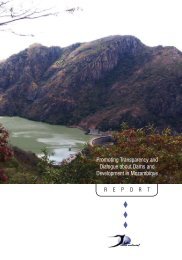Mountains of Concrete - International Rivers
Mountains of Concrete - International Rivers
Mountains of Concrete - International Rivers
Create successful ePaper yourself
Turn your PDF publications into a flip-book with our unique Google optimized e-Paper software.
our souls through this river…The hills, the rivers andthe mountains are deeply embedded in our ethos.It is the life force <strong>of</strong> our community. Destructionor endangerment <strong>of</strong> these will be a threat to thecommunity itself. Development at the cost <strong>of</strong> cultureand tradition is not acceptable to us.These two factors – the influx <strong>of</strong> large numbers <strong>of</strong>migrants and the destruction <strong>of</strong> the natural ecosystem thatis integral to the tribal community – are therefore likely tothreaten the very identity and culture <strong>of</strong> several communitieswho are already endangered due to small population size.Dam building in the Himalayas will also lead to thesubmergence <strong>of</strong> places <strong>of</strong> religious or historical significance.The Shaligram Shila, a very important religious site forHindus, now remains submerged quite <strong>of</strong>ten due to theKaligandaki project in Nepal. 94 The Bhagirathi River, sacredin India, is threatened by the number <strong>of</strong> projects planned onit. A huge treasure trove <strong>of</strong> rock carvings, dating back fromancient times, has been found along the Indus where theDiamer-Bhasha reservoir is planned. 95 All <strong>of</strong> these will besubmerged by the reservoir.Such impacts are likely to be seen in many <strong>of</strong> theprojects, as rivers have been the cradles <strong>of</strong> the earliest humancivilisations and centres <strong>of</strong> religious and spiritual significancefor most human societies.Ecological ImpactsThe Himalayas are recognized not only as a hotspot<strong>of</strong> biodiversity but also for their fragility. Conservation<strong>International</strong> 96 lists the Himalayas among the biodiversityhotspots <strong>of</strong> the world and says thatThe abrupt rise <strong>of</strong> the Himalayan <strong>Mountains</strong> fromless than 500 meters to more than 8,000 metersresults in a diversity <strong>of</strong> ecosystems that range, inonly a couple <strong>of</strong> hundred kilometers, from alluvialgrasslands (among the tallest in the world) andsubtropical broadleaf forests along the foothills totemperate broadleaf forests in the mid hills, mixedconifer and conifer forests in the higher hills, andalpine meadows above the treeline. 97Conservation <strong>International</strong> also says that <strong>of</strong> theestimated 10,000 species <strong>of</strong> plants in the Himalayas, about3,160 are endemic, as are 71 genera. Furthermore, five plantfamilies are endemic to the region. 98 About 300 mammalspecies have been recorded in the Himalayas, including adozen that are endemic.The Indian Ministry <strong>of</strong> Environment and Forests’Environmental Information System (ENVIS) 99 also talksabout the rich and diverse ecology <strong>of</strong> the Himalayan region.For Arunachal Pradesh, it says:The state is situated in the Eastern Himalaya and isthe richest biogeographical province <strong>of</strong> the entireIndian Himalayan zone. The province has beenSnow Leopard. Dam building in the Himalayas is a threat to animalsand endangered species such as the snow leopard. Photo: FritzPolking. Courtesy: Snow Leopard Trust.identified as one <strong>of</strong> the world’s 18 biodiversityhotspots. The richness <strong>of</strong> life forms, i.e., the flora andfauna that occur in these forests presents a panorama<strong>of</strong> biological diversity with over 5,000 plants,about 85 terrestrial mammals, over 500 birds and alarge number <strong>of</strong> butterflies, insects and reptiles. Thisdiversity <strong>of</strong> topographical and climatic conditionshas favoured the growth <strong>of</strong> luxuriant forests that arehome to myriad plant and animal forms addingbeauty to the landscape. 100In the case <strong>of</strong> Sikkim, it states that “Its uniquegeographical position, varied topography and high annualrainfall make the state a treasure house <strong>of</strong> flowering plants.The vegetation <strong>of</strong> tropical forests occurring up to 900 mconsists <strong>of</strong> moist deciduous to semi-evergreen tree species.Sikkim is famous for its orchids and harbours about 45% <strong>of</strong>[the] orchid species found in the country.” 101These two states are planning to build a huge number <strong>of</strong>dams. This is likely to have very serious effects on biodiversitydue to the destruction <strong>of</strong> habitats, natural ecosystems, floraand fauna. 102Many aspects <strong>of</strong> dam building, like the submergence <strong>of</strong>forests, large scale river diversions, disruption <strong>of</strong> aquatic ecosystems– both upstream and downstream, blasting, digging,excavation, debris dumping and other construction-relatedactivities, are likely to wreak havoc on the ecology <strong>of</strong> theHimalayan region.Conservation <strong>International</strong> identifies the construction<strong>of</strong> big dams in the region as a threat to biodiversity andforests, along with habitat loss and degradation, mining andpollution from agrochemicals. 103M o u n ta i n s o f C o n c r e t e : D a m B u i l d i n g i n t h e H i m a l aya s | 2 7
















